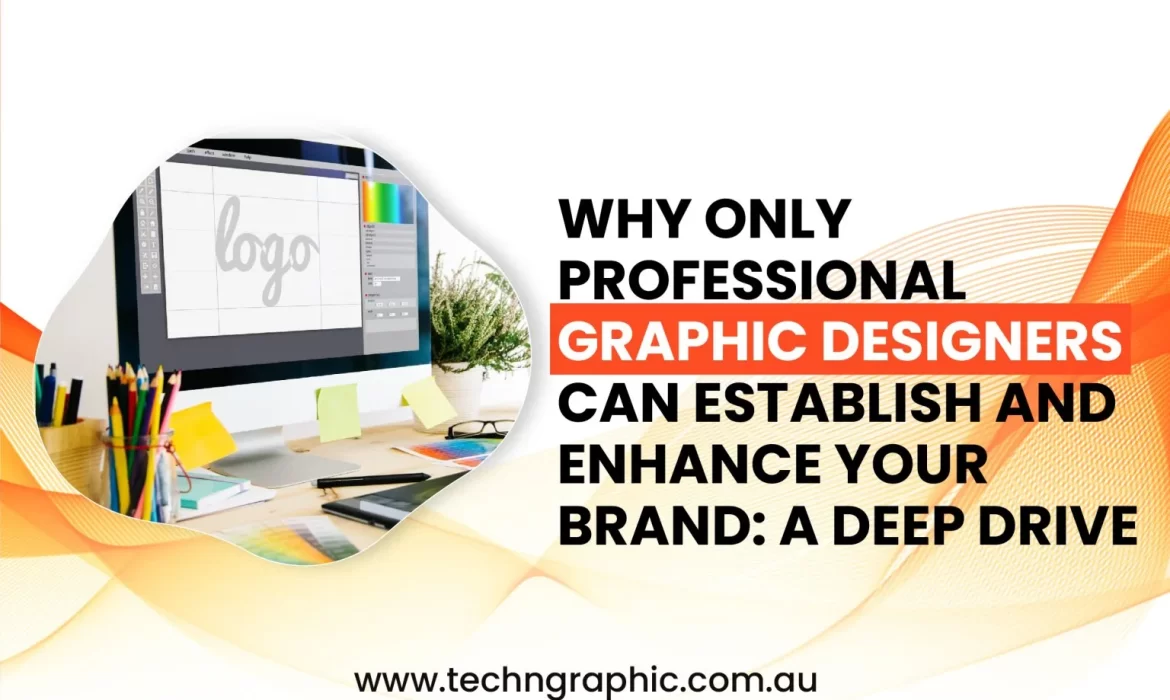Establishing a strong brand presence is crucial in today’s highly competitive digital landscape. Brands are not just about logos and colors; they encapsulate a business’s identity, values, and promise to customers. A well-established brand can command higher customer loyalty, charge premium prices, and stand out in the sea of competitors. However, building and enhancing a brand cannot be achieved with basic design skills or DIY tools—this is where the role of a professional graphic designer becomes indispensable.
In this article, we will explore:
- The integral role of a professional graphic designer in brand establishment.
- How a designer’s expertise in design principles enhances brand recognition.
- Why DIY tools can’t replace professional graphic design.
- Statistical insights showing the impact of professional design on brand success.
- The future of branding and why professional graphic design remains critical.
Let’s dive in.
1. The Integral Role of a Professional Graphic Designer in Brand Establishment
The Brand Beyond The Logo: Many people associate branding with a company’s logo. However, branding extends beyond just visual elements; it encompasses everything from tone of voice, and messaging, to customer interaction. Professional graphic designers understand how to weave these elements together into a cohesive brand identity that reflects a company’s mission and resonates with the target audience.
Expertise in Brand Strategy: A professional designer begins by understanding your brand values, target market, and competition. Through in-depth research and collaboration, they help define your brand’s vision and how it should be perceived in the marketplace. This strategic understanding forms the foundation for your visual identity.
2. How A Designer’s Expertise in Design Principles Enhances Brand Recognition
Understanding the Principles of Design:
Professional graphic designers don’t just create visually appealing images; they employ design principles like balance, alignment, contrast, repetition, and hierarchy to guide viewers’ eyes and deliver the brand’s message effectively. Without these fundamentals, visuals can appear cluttered, confusing, or ineffective at communicating a brand’s identity.
Let’s break down how these principles work:
- Balance: Ensures visual stability through symmetrical or asymmetrical layouts.
- Contrast: Differentiates key elements, making information digestible and clear.
- Hierarchy: Directs attention to the most important aspects, ensuring your brand message is clear.
Color Psychology:
Colors evoke emotions and shape perceptions, making them a critical aspect of branding. Professional graphic designers use color psychology to trigger desired emotions in consumers. For instance, blue conveys trust and stability, which is why tech companies like IBM and Facebook rely on it. Red, on the other hand, symbolizes urgency and passion, commonly used by food brands like Coca-Cola.
| Color | Emotion Triggered | Brand Examples |
| Blue | Trust, Stability | IBM, Facebook, Visa |
| Red | Urgency, Passion | Coca-Cola, Netflix, CNN |
| Green | Growth, Health | Starbucks, Whole Foods |
| Yellow | Optimism, Warmth | McDonald’s, Ikea |
| Black | Luxury, Sophistication | Chanel, Nike |
Typography:
Typography goes beyond picking a font; it involves choosing the right typeface that aligns with the brand’s identity. Designers understand how to use typography to create consistency, evoke emotions, and ensure readability. For instance, luxury brands often opt for serif fonts to convey elegance, while tech startups may use sans-serif fonts for a clean, modern look.
3. Why DIY Tools Can’t Replace Professional Graphic Design
In an era of drag-and-drop design tools, many business owners may be tempted to skip the costs associated with hiring a professional designer. However, these DIY tools come with serious limitations.
Limited Customization: DIY tools offer pre-made templates, but these templates are also accessible to your competitors. This lack of customization results in generic branding that fails to stand out in a crowded market. A professional designer creates bespoke visual elements tailored specifically for your brand, ensuring uniqueness and authenticity.
Inconsistent Branding: One of the key issues with DIY design tools is inconsistency. DIY designers may not have a keen eye for alignment, proportion, or typography, leading to a brand identity that lacks cohesion. This inconsistency confuses your audience and dilutes your brand message.
Lack of Professional Insight: A seasoned graphic designer understands design trends, market shifts, and how to future-proof a brand. DIY users, on the other hand, may lack the experience or insight needed to anticipate design issues or evolving trends that could affect the longevity of their branding.
4. Statistical Insights on the Impact of Professional Design
Branding as a Business Investment
The significance of professional design is reflected in the impact it has on a company’s bottom line. Professionally designed brands have a much higher chance of long-term success, higher customer retention, and greater customer trust.
Customer Perception and Trust: Design directly influences trust. A Stanford University study found that 75% of users judge a company’s credibility based on its website design. This perception is carried over to other aspects of your business, whether it’s your packaging, business cards, or social media presence.
Conversion Rates:A Blue Corona study found that a well-designed website can increase conversion rates by up to 200%. Additionally, consistent branding across all platforms can improve revenue by 23%.
5. The Future of Branding: Why Professional Graphic Design Remains Critical
As businesses evolve, so do consumer expectations. With the advent of new technologies like augmented reality (AR), artificial intelligence (AI), and voice search, the way brands communicate visually is also changing. A professional graphic designer is well-versed in these emerging technologies and understands how to integrate them into a branding strategy.
The Rise of Motion Graphics and Interactive Design
Motion graphics, 3D design, and interactive elements are becoming integral to modern branding. These dynamic elements help brands engage audiences in ways that static images cannot. Professional graphic designers are trained to create such visuals, ensuring that your brand remains relevant in a world of fast-evolving digital experiences.
Adapting to Multichannel Branding
A brand’s visual identity must be adaptable across a variety of channels—social media, websites, apps, physical stores, and even virtual spaces like the metaverse. Professional designers understand how to maintain brand consistency across all these touchpoints, ensuring a unified brand experience.
Transform your brand today! Hire a professional graphic designer who understands the future of branding and ensures your business stands out across every platform.
AI and Data-Driven Design
Incorporating data into design decisions is a growing trend. Professional graphic designers use data analytics to understand how customers interact with designs and which visuals drive the most engagement. AI-based tools can optimize this process, but it takes a skilled designer to interpret this data and turn it into actionable insights for enhancing brand performance.
Ready to future-proof your brand? Partner with a professional designer to incorporate cutting-edge trends like AI and interactive graphics into your brand strategy.
Final Thoughts: Why Professional Graphic Designers Are the Key to Building Your Brand
In an ever-evolving business landscape, your brand is your most valuable asset. Building and enhancing this asset requires more than just a logo or a few well-placed visuals. A professional graphic designer brings expertise, creativity, and strategic insight to the table, ensuring that every design decision aligns with your brand’s goals and resonates with your audience.
Key Takeaways:
- Professional designers understand how to communicate brand values through design.
- DIY tools can’t compete with the customized, strategic approach professionals offer.
- Good design improves customer trust, engagement, and overall business success.
- The future of branding will require expertise in emerging technologies, which professional designers are best equipped to handle.
Don’t risk the success of your brand with DIY solutions. Contact us today to ensure your brand is ready to lead in the digital age.
Conclusion
Investing in professional graphic design is no longer a luxury—it’s a necessity. With customers making split-second decisions based on visual cues, your brand’s image can make or break your business. Don’t leave your brand’s future to chance. Partner with a professional graphic designer who can provide the expertise, creativity, and strategic thinking needed to build a lasting brand that not only meets but exceeds customer expectations.
In an age where competition is fierce and attention spans are short, your brand needs to communicate effectively, immediately, and consistently. Only a professional graphic designer can provide that level of service, ensuring your business stays ahead of the curve.



